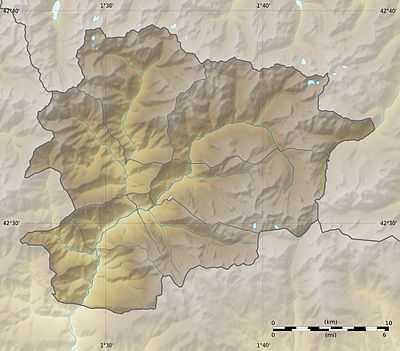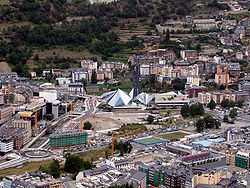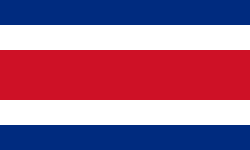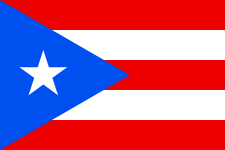Andorra la Vella
| Andorra la Vella | ||
|---|---|---|
|
View of Andorra la Vella and a small part of Escaldes-Engordany | ||
| ||
 Position of Andorra la Vella parish in Andorra | ||
 Andorra la Vella Location within Andorra | ||
| Coordinates: 42°30′N 01°30′E / 42.500°N 1.500°E | ||
| Country |
| |
| Parishes | Andorra la Vella | |
| Villages | La Margineda, Santa Coloma | |
| Government | ||
| • Cònsol Major | Maria Rosa Ferrer Obiols | |
| Area | ||
| • Total | 12 km2 (5 sq mi) | |
| Elevation | 1,023 m (3,356 ft) | |
| Population (2011) | ||
| • Total | 22,256[1] | |
| Demonym |
Andorran andorrà, andorrana (ca) | |
| Website | Official site | |
Andorra la Vella (Catalan pronunciation: [ənˈdorə ɫə ˈβeʎə], locally: [anˈdɔra la ˈβeʎa]) is the capital of the Principality of Andorra, and is located high in the east Pyrenees between France and Spain. It is also the name of the parish that surrounds the capital.
As of 2011, the city has a population of 22,256, and the urban area, which includes Escaldes-Engordany plus satellite villages, has over 40,000 inhabitants.
The principal industry is tourism, although the country also earns foreign income from being a tax haven. Furniture and brandies are local products. Being at an elevation of 1,023 metres (3,356 ft), it is the highest capital city in Europe and a popular ski resort.
History

The site of Andorra la Vella (literally, "Andorra the City", not "Andorra the Old" as is often misunderstood) has been settled since prior to the Christian era—notably by the Andosin tribe from the late Neolithic. The state is one of the Marca Hispanica created and protected by Charlemagne in the eighth century as a buffer from the Moorish settlers in the Iberian Peninsula.[2]
The settlement of Andorra la Vella has been the principal city of Andorra since 1278 when the French and the Episcopal co-princes agreed to joint suzerainty. Andorra la Vella's old town—the Barri Antic—includes streets and buildings dating from this time. Its most notable building is the Casa de la Vall—constructed in the early sixteenth century—which has been the state's parliamentary house since 1702. Andorra la Vella was, during this period, the capital of a largely isolated and feudal state, which retained its independence due to this principle of co-sovereignty.
Well into the twentieth century, the area around Andorra la Vella remained largely forgotten; indeed the state was not part of the Treaty of Versailles, simply because it was not noticed. After political turmoil in the 1930s and an attempted coup by Boris Skossyreff, an informal democracy developed.
In 1993, the country's first constitution formalised this parliamentary democracy with executive, legislative, and judicial branches located in Andorra la Vella.
During this period, Andorra also developed as a tax haven, resulting in the construction of modern banking offices in Andorra La Vella. The city also developed its skiing facilities, to the extent that Andorra la Vella was Andorra's applicant city for the XXI Olympic Winter Games, the 2010 Winter Olympics. However, Andorra la Vella was not selected by the IOC as a candidate city, following the evaluation report of an IOC commission. It also hosted both the 1991 and 2005 Games of the Small States of Europe.
Geography
Andorra la Vella is located in the south west of Andorra, at 42°30′N 1°30′E / 42.500°N 1.500°E,[3] at the confluence of two mountain streams, the Valira del Nord (Northern Valira) and the Valira de l'Orient (Eastern Valira), which join to form the Gran Valira. It adjoins the urban area of Escaldes-Engordany. The city is at 1,023 metres (3,356 ft) above sea level.
Climate
Andorra la Vella has an oceanic climate (Cfb, according to the Köppen climate classification), with mild summers and chilly to cold, snowy winters. The average annual precipitation is 899 mm (35 in).
| Climate data for Andorra la Vella | |||||||||||||
|---|---|---|---|---|---|---|---|---|---|---|---|---|---|
| Month | Jan | Feb | Mar | Apr | May | Jun | Jul | Aug | Sep | Oct | Nov | Dec | Year |
| Average high °C (°F) | 5.7 (42.3) |
7.1 (44.8) |
9.8 (49.6) |
12.2 (54) |
16.0 (60.8) |
20.1 (68.2) |
23.3 (73.9) |
23.0 (73.4) |
19.7 (67.5) |
14.7 (58.5) |
9.7 (49.5) |
5.7 (42.3) |
13.92 (57.07) |
| Daily mean °C (°F) | 2.3 (36.1) |
3.1 (37.6) |
5.5 (41.9) |
7.6 (45.7) |
11.3 (52.3) |
15.2 (59.4) |
18.1 (64.6) |
18.0 (64.4) |
15.2 (59.4) |
10.6 (51.1) |
6.0 (42.8) |
2.8 (37) |
9.64 (49.36) |
| Average low °C (°F) | −1.1 (30) |
−0.8 (30.6) |
1.2 (34.2) |
3.0 (37.4) |
6.6 (43.9) |
10.3 (50.5) |
13.0 (55.4) |
13.0 (55.4) |
10.8 (51.4) |
6.5 (43.7) |
2.3 (36.1) |
0.0 (32) |
5.4 (41.72) |
| Average precipitation mm (inches) | 51 (2.01) |
54 (2.13) |
66 (2.6) |
74 (2.91) |
102 (4.02) |
101 (3.98) |
65 (2.56) |
89 (3.5) |
83 (3.27) |
74 (2.91) |
72 (2.83) |
68 (2.68) |
899 (35.4) |
| Source: Climate-data.org[4] | |||||||||||||
Subdivisions

The parish of Andorra la Vella is divided into the villages of Andorra la Vella itself, La Margineda and Santa Coloma.
Transportation
As a result of its population size and highly mountainous terrain, Andorra la Vella has no airport of its own, but has a heliport and is a three-hour drive from the nearest airports at Toulouse (Tolosa), Girona, Perpignan and Barcelona.[5] It also has no train station, although there are bus shuttle services linking the capital to train stations at L'Hospitalet-près-l'Andorre (France) and Lleida in Spain. There are also a shuttle bus from Barcelona, Girona and Reus' airports to Andorra la Vella.[6]
Demographics and language
Native Andorrans, who are ethnically Catalan, account for only a third (33%) of the population, with the plurality being Spanish (43%), and notable minorities of Portuguese (11%) and French (7%). Catalan is the official language, although Spanish, Portuguese and French are also spoken. Most of the inhabitants are Roman Catholics, with a high life expectancy of over 80 years.[7]
| Largest groups of foreign residents | |
| Nationality | Population (2013) |
|---|---|
| 6,516 | |
| 3,377 | |
| 664 | |
| 246 | |
| 218 | |
Sights and culture
The city's old town is characterized by old stone streets and houses. The central Església de Sant Esteve (Saint Stephen) church is part of the area that guidebooks often label as a picturesque part of the city.[8] This was built in a Romanesque style in the eleventh century. As mentioned earlier, the old town also includes the country's historic parliament building. Probably the oldest building in the city is another church, dating from the ninth century, of Santa Coloma.[9]
The city is the country's cultural centre, with the Government Exhibition Hall acting as a main theatre and museum. The piazza outside the parliament building is also the location of a number of events, and the town hosts a music festival every winter.
Economy
Andorra la Vella is the country's commercial centre. In the country as a whole, 80% of the GDP is derived from the 10 million tourists who visit annually.[10] The city is also the centre for the many banks and businesses that thrive from its tax haven status. The state is not a member of the European Union, but has a customs arrangement with the EU, and uses the euro.

Notable people
- The Andorran ski mountaineers Joan Vilana Díaz and Sophie Dusautoir Bertrand were born in Andorra la Vella.
International relations
Twin towns – sister cities
Andorra la Vella is part of the Union of Ibero-American Capital Cities[11] from October 12, 1982 establishing brotherly relations with the following cities:
 Madrid, Spain
Madrid, Spain Asunción, Paraguay
Asunción, Paraguay Bogotá, Colombia
Bogotá, Colombia Buenos Aires, Argentina
Buenos Aires, Argentina Caracas, Venezuela
Caracas, Venezuela Guatemala City, Guatemala
Guatemala City, Guatemala Havana, Cuba
Havana, Cuba Quito, Ecuador
Quito, Ecuador La Paz, Bolivia
La Paz, Bolivia Lisbon, Portugal
Lisbon, Portugal Managua, Nicaragua
Managua, Nicaragua Mexico City, Mexico
Mexico City, Mexico Montevideo, Uruguay
Montevideo, Uruguay Panama City, Panama
Panama City, Panama Rio de Janeiro, Brazil
Rio de Janeiro, Brazil San Jose, Costa Rica
San Jose, Costa Rica San Juan, Puerto Rico
San Juan, Puerto Rico San Salvador, El Salvador
San Salvador, El Salvador Santiago, Chile
Santiago, Chile Santo Domingo, Dominican Republic
Santo Domingo, Dominican Republic Tegucigalpa, Honduras
Tegucigalpa, Honduras Sant Pol de Mar, Spain
Sant Pol de Mar, Spain Valls, Spain
Valls, Spain
References
- ↑ Andorra
- ↑ "History of the Principality of Andorra". Andorramania.com. 1997-12-11. Retrieved 2010-06-27.
- ↑ "NGA: Country Files". Earth-info.nga.mil. Retrieved 2010-06-27.
- ↑ "Climate: Andorra la Vella". Climate-data.org.
- ↑ How to get to Andorra by Plane
- ↑ How to get to Andorra by Bus
- ↑ CIA - The World Factbook - Andorra
- ↑ "The beautiful Andorra la Vella". Eslteachersboard.com. Retrieved 2010-06-27.
- ↑ "Andorra la vella travel guide". World66.com. Retrieved 2010-06-27.
- ↑ "CruisesOnly - About Cruising - Cruise Advice". Nlgsolutions.com. Retrieved 2010-06-27.
- ↑ "Declaración de Hermanamiento múltiple y solidario de todas las Capitales de Iberoamérica (12-10-82)" (PDF). Retrieved 2010-01-31.
External links
| Wikimedia Commons has media related to Andorra la Vella. |
- City council of Andorra la Vella (Catalan)
- MSN Map
- Sant Esteve church in Circulo Romanico page
- Santa Coloma Church in Circulo Romanico page
| ||||||||||||||||||||||||||
